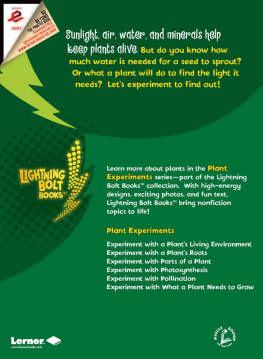Higgins - Grow the Best Asparagus
Here you can read online Higgins - Grow the Best Asparagus full text of the book (entire story) in english for free. Download pdf and epub, get meaning, cover and reviews about this ebook. City: Charlotte;VT, year: 1981, publisher: Storey Publishing, LLC;Garden Way Pub, genre: Children. Description of the work, (preface) as well as reviews are available. Best literature library LitArk.com created for fans of good reading and offers a wide selection of genres:
Romance novel
Science fiction
Adventure
Detective
Science
History
Home and family
Prose
Art
Politics
Computer
Non-fiction
Religion
Business
Children
Humor
Choose a favorite category and find really read worthwhile books. Enjoy immersion in the world of imagination, feel the emotions of the characters or learn something new for yourself, make an fascinating discovery.

Grow the Best Asparagus: summary, description and annotation
We offer to read an annotation, description, summary or preface (depends on what the author of the book "Grow the Best Asparagus" wrote himself). If you haven't found the necessary information about the book — write in the comments, we will try to find it.
Grow the Best Asparagus — read online for free the complete book (whole text) full work
Below is the text of the book, divided by pages. System saving the place of the last page read, allows you to conveniently read the book "Grow the Best Asparagus" online for free, without having to search again every time where you left off. Put a bookmark, and you can go to the page where you finished reading at any time.
Font size:
Interval:
Bookmark:
Michael Higgins
The mission of Storey Publishing is to serve our customers by publishing practical information that encourages personal independence in harmony with the environment.
Cover illustration by Beverly Duncan
Cover design by Carol J. Jessop (Black Trout Design)
1981 by Storey Publishing, LLC
All rights reserved. No part of this bulletin may be reproduced without written permission from the publisher, except by a reviewer who may quote brief passages or reproduce illustrations in a review with appropriate credits; nor may any part of this bulletin be reproduced, stored in a retrieval system, or transmitted in any form or by any means electronic, mechanical, photocopying, recording, or other without written permission from the publisher.
The information in this bulletin is true and complete to the best of our knowledge. All recommendations are made without guarantee on the part of the author or Storey Publishing. The author and publisher disclaim any liability in connection with the use of this information. For additional information please contact Storey Publishing, 210 MASS MoCA Way, North Adams, MA 01247.
Storey books and bulletins are available for special premium and promotional uses and for customized editions. For further information, please call 1-800-793-9396.
Printed in the United States by Excelsior
Higgins, Michael
Grow the best asparagus / by Michael Higgins
A Storey Publishing Bulletin, A-63
ISBN 978-0-88266-277-0
In the early spring, when other fresh vegetables are unavailable, how pleasant it is to have one of the tastiest vegetables ready to harvest. And it is reassuring to know that the harvest will continue each spring for years to come. A well-prepared asparagus bed, in good soil, should produce abundantly for up to twenty-five years. If you can be patient in the beginning, you will be rewarded by a wonderful return for your labor.
A gourmet treat, expensive when purchased (and never as fresh), asparagus can be grown in almost any garden where there is a cold or dry season to provide it with a dormant period. As a vegetable, the versatile asparagus can be cooked in many ways and dried, canned, or frozen for off-season eating. Low in calories, high in flavor, each serving of four spears (sixty grams) contains only ten calories, with two grams of carbohydrates and one gram of protein. Asparagus is a very good source of thiamin and a good source of vitamin A and riboflavin.
The asparagus plant is a beautiful addition to any location. Few garden sights are more attractive than early dew glistening in the feathery, dark green foliage of the summer plants. In the fall, the asparagus fern turns a bright yellow, and when snow is on the ground, the light brown brush bends high over the white.
Asparagus grows wild in so many areas throughout the world that it is hard to pinpoint its place of origin. Both the Greeks and the Romans cultivated the plant. In fact, when the Romans wanted to indicate a very short time, they would say, In the time it takes to cook asparagus. They also dried the vegetable to use in the winter.
With its high tolerance for salt and its preference for sandy soils, wild asparagus is found in sandy or coastal locations in places as varied as England, central Wisconsin, and the steppes of Russia and Poland. It has been grown in Syria, Egypt (where it is pictured on ancient reliefs), and Spain since ancient times. In the sixteenth century, it appeared in France and England, and from there it was brought to America by the early colonists.
Besides enjoying it as a tasty vegetable, the early cultivators believed asparagus had certain medicinal properties. The Greeks and Romans valued asparagus as a diuretic and gentle laxative. The English herbalist Culpepper made much more extravagant claims; he declared that asparagus could be used to clear the sight, ease the toothache, and help the sciatica.
Asparagus spears are candied in China. In other areas of the world, seeds are used to make a coffee substitute and are fermented to produce an alcoholic drink. But it is as a delicious vegetable that asparagus is so widely popular. Today the Dutch and Italians grow a purple variety; the white argenteiul of France is considered tops by gourmets, and the green shades of the Washington strains are found everywhere in the United States.
Asparagus (Asparagus officinalis) is an edible member of the lily family. Despite its deserved reputation as a gourmet vegetable and its high market price, it is a hardy plant and is widely cultivated by home gardeners. The main requirement for growing asparagus is a little patience; you have to wait one or two growing seasons after planting before you can begin harvesting.
Although asparagus can be grown almost anywhere, good production is based on a carefully chosen site. Plant your asparagus where it will be neither crowded (especially by trees) nor in the way. Remember, asparagus is a perennial, so plan for a permanent location. Allow four feet between the asparagus row and any other planting. Some gardeners put all their asparagus in a single row along the edge of the garden or in a row dividing the flower garden from the vegetable garden. The tall summer and fall foliage makes a pleasant background for an area of colorful flowers. Do not put your bed where the plants will shade nearby crops, unless you want to use that shade to advantage when you need a cool spot to put in midsummer lettuce or other plants that require some shade.
Asparagus itself requires full sun; a slight slope facing south will help to give it an early start. It should not be subjected to strong winds. If a windy location is all you have, it may be necessary to stake the plants once the harvesting season is over.
Ideally, the soil should be a well-drained, rich, sandy loam; heavier clay soils should be conditioned with plenty of organic matter. If you have no place to put your asparagus but in a poorly drained spot, raised beds can help a great deal. To make a raised bed, dig the soil deeply. Add additional organic soil to raise the level of the bed one foot. The sides of the bed can be contained by concrete blocks or railroad ties. Or you can let the sides of the bed slope down naturally. The bed will remain in its loose, fluffed up condition as long as you do not walk on it.
Finally, since you may need to irrigate occasionally, a handy water supply can be important.

There are three basic types of soil: sandy soil; silty soil, and clayey soil. Mixtures of the three are called loamy soils. Sandy soils have coarse, gritty individual particles that do not adhere when wet. Clayey soils are sticky when wet and have the finest individual soil particles.
How many plants to grow depends, of course, on how much you like asparagus and how much you plan to freeze, can, or dry. Ten plants per person is an average crop, but a family that wants plenty for eating fresh, giving to friends, and for winter keeping can use at least twice that amount.
You can start your asparagus from seeds or from roots. Growing from seeds is cheaper; growing from roots yields quicker results. When you start from seed, you can plant extra and then select the best plants. Then you will not have to worry about root damage from shipping. In addition, the United States Department of Agriculture is now warning gardeners about a prevalent disease, fusarium rot, and claims that the only way to guarantee disease-free plants is to start with treated seeds. You can treat your own seeds (as described on pages 6-7) and you may be able to obtain free seeds from a gardening friend with an established bed.
Font size:
Interval:
Bookmark:
Similar books «Grow the Best Asparagus»
Look at similar books to Grow the Best Asparagus. We have selected literature similar in name and meaning in the hope of providing readers with more options to find new, interesting, not yet read works.
Discussion, reviews of the book Grow the Best Asparagus and just readers' own opinions. Leave your comments, write what you think about the work, its meaning or the main characters. Specify what exactly you liked and what you didn't like, and why you think so.

















